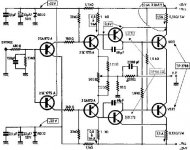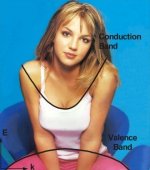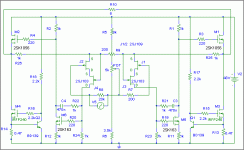Jocko, et al,
thanks for the info.
Why is it that we're in the 21st century and still no one seems to be able to quantify "it just doesn't sound right" on something that measures excellently on at least a necessary, though obviously not sufficient, set of "objective" criteria?
I'm surely not saying that these "subjective" conclusions aren't real as I've heard such "differences" reliably, but I just don't believe that one has to resort to psuedo-scientific explanations to "quantify" the differences
Borbely has picked up on Cordell's tri-tone intermod test and that sounds promising to me since he states it correlates well to his subjective impressions. Maybe I need to build up one of these test setups.
thanks for the info.
Why is it that we're in the 21st century and still no one seems to be able to quantify "it just doesn't sound right" on something that measures excellently on at least a necessary, though obviously not sufficient, set of "objective" criteria?
I'm surely not saying that these "subjective" conclusions aren't real as I've heard such "differences" reliably, but I just don't believe that one has to resort to psuedo-scientific explanations to "quantify" the differences
Borbely has picked up on Cordell's tri-tone intermod test and that sounds promising to me since he states it correlates well to his subjective impressions. Maybe I need to build up one of these test setups.
Hi, Paul!
I happened to see your post above re the AKSA and thought I'd say hello.
Although I'm not good at the Stereophile description stuff, I agree with Paul that the AKSA is a fine, fine amp -- and I say that although I'm generally biased (no pun intended) against ss amps. The 100W AKSA that I put together (which is the amp that pmkap heard) is basically bone stock and had only a bare minimum of breakin when we listened.
That said, if you're going down to 2R, Mr. Feedback, you may need to look elsewhere. I think the 100W AKSA is fine with 4R, but 2R (!) is quite a load. No doubt your countryman Hugh Dean can you provide you with further information on this score.
I happened to see your post above re the AKSA and thought I'd say hello.
Although I'm not good at the Stereophile description stuff, I agree with Paul that the AKSA is a fine, fine amp -- and I say that although I'm generally biased (no pun intended) against ss amps. The 100W AKSA that I put together (which is the amp that pmkap heard) is basically bone stock and had only a bare minimum of breakin when we listened.
That said, if you're going down to 2R, Mr. Feedback, you may need to look elsewhere. I think the 100W AKSA is fine with 4R, but 2R (!) is quite a load. No doubt your countryman Hugh Dean can you provide you with further information on this score.
Re: Current-feedback amps
Hi Jocko,
integrated CFB op amps usually have 10-50x the settling time to 0.01% compared to a good VFB op amp that has similar specs (i.e. bandwidth and settling to 0.1%). I have yet to find an intelligable explanation why that is so...
I have toyed the thought of building the Alexander amp for a long time. Its greatest advantage is that the buffer that converts the input voltage into a current is not an open loop design as in almost any other CFB amp. The type of VFB op amp used for this and the way it gets its supply leave room for improvement, though. Also, I think the big IGBT enthusiam has dwindled, wonder why...
What modifications of the Alexander design have you tried?
On a side note: rather than trying A/B tests that can be confounding, I am swapping the op amps in my DAC on a weekly basis, trying to find out which one I like to live with. The LM6172, which is a CFB design in disguise, has its strong points, but so far I allways seem to like pure VFBs better in the long run...
Eric
Jocko Homo said:Built several permutations of the Alexander amp, and they all sounded like every other current-feedback project I've worked on.
As Mr. Horse would say...."No, sir, I don't care for it at all."
Can't describe it, but it just doesn't sound right. And everyone who heard any of them said the same.
Jocko
Hi Jocko,
integrated CFB op amps usually have 10-50x the settling time to 0.01% compared to a good VFB op amp that has similar specs (i.e. bandwidth and settling to 0.1%). I have yet to find an intelligable explanation why that is so...
I have toyed the thought of building the Alexander amp for a long time. Its greatest advantage is that the buffer that converts the input voltage into a current is not an open loop design as in almost any other CFB amp. The type of VFB op amp used for this and the way it gets its supply leave room for improvement, though. Also, I think the big IGBT enthusiam has dwindled, wonder why...
What modifications of the Alexander design have you tried?
On a side note: rather than trying A/B tests that can be confounding, I am swapping the op amps in my DAC on a weekly basis, trying to find out which one I like to live with. The LM6172, which is a CFB design in disguise, has its strong points, but so far I allways seem to like pure VFBs better in the long run...
Eric
"Doesn't quite sound right........"
I suspect a lot of it is psychoacustics. I read an article in JAES about 22 years ago that made the point we still have no way of determining how and where a given distortion mechanism will affect a musical note. And we still don't.
As for the Alexander thing, I can't remember all the things we tried, but they all sounded the same. Even the CFB amp built from scratch with discrete parts. And all the line stages and I/Vs we messed with.
If you do build any, the non-inverting version is harder to stabilize.
Jocko
I suspect a lot of it is psychoacustics. I read an article in JAES about 22 years ago that made the point we still have no way of determining how and where a given distortion mechanism will affect a musical note. And we still don't.
As for the Alexander thing, I can't remember all the things we tried, but they all sounded the same. Even the CFB amp built from scratch with discrete parts. And all the line stages and I/Vs we messed with.
If you do build any, the non-inverting version is harder to stabilize.
Jocko
Eric,
give me some time, i am currently building an AKSA 100W amp.
I wanted to have a 100W subwoofer amp matching to the tube amps i like best. Due to recommendation by my friend Manfred who was about the AKSA's subwoofer preformance, i didn't dillydally around with other choices and ordered it.
The kit is already sitting here and the housing gets built within the next week or so. I decided to make this amp usable both for subwoofer use (built-in open-baffle subwoofer XO) and as fullrange amp as i really want to know whether i can be happy with a SS amp after so many years with tubes. Moreover, i equipped the amp with a proper 600 R input trannie to make it usable both for 47k and 600R input impedance. Driving an open-baffle subwoofer, the amp will have to work quite hard. But power should be enuff. I come back with results as soon as the thing is up and running.
All,
the best SS amp i heard so far are the 15 year old 30W Hiraga from L'Audiophile, Paris and the 8 watt "Le Monstre". Unless the Monstre is fed by batteries (170Ah) i could not decide which to prefer (probably the Hiraga) but a battery monster is really something,
Apart from that i heard solme very nice DC-coupled amps, but none was as vivid and juicy as the Hiraga 30W. Hadn't i needed more power, i would have built a Hiraga.
But i must admit i have not cared much for SS amps in the recent years.
give me some time, i am currently building an AKSA 100W amp.
I wanted to have a 100W subwoofer amp matching to the tube amps i like best. Due to recommendation by my friend Manfred who was about the AKSA's subwoofer preformance, i didn't dillydally around with other choices and ordered it.
The kit is already sitting here and the housing gets built within the next week or so. I decided to make this amp usable both for subwoofer use (built-in open-baffle subwoofer XO) and as fullrange amp as i really want to know whether i can be happy with a SS amp after so many years with tubes. Moreover, i equipped the amp with a proper 600 R input trannie to make it usable both for 47k and 600R input impedance. Driving an open-baffle subwoofer, the amp will have to work quite hard. But power should be enuff. I come back with results as soon as the thing is up and running.
All,
the best SS amp i heard so far are the 15 year old 30W Hiraga from L'Audiophile, Paris and the 8 watt "Le Monstre". Unless the Monstre is fed by batteries (170Ah) i could not decide which to prefer (probably the Hiraga) but a battery monster is really something,
Apart from that i heard solme very nice DC-coupled amps, but none was as vivid and juicy as the Hiraga 30W. Hadn't i needed more power, i would have built a Hiraga.
But i must admit i have not cared much for SS amps in the recent years.
Hiraga
I have heard good reports on this design. How about an some suggestions for different output drivers and outputs. I wouldn't change the front end.
http://www.jls-info.com/julien/audio/index1.htm
Monster:
http://www.infomaniak.ch/~bonavolt/monster.htm
H.H.
I have heard good reports on this design. How about an some suggestions for different output drivers and outputs. I wouldn't change the front end.
http://www.jls-info.com/julien/audio/index1.htm
Monster:
http://www.infomaniak.ch/~bonavolt/monster.htm
H.H.
Attachments
Harry
If you are going to post links related to the Hiraga designs, why not include the site that has the full articles for both the 20W and 'Le Monstre' instead of sites that just have a schematic and a few photographs?
The site in question can be accessed from the icon below (ie it's mine
Geoff
If you are going to post links related to the Hiraga designs, why not include the site that has the full articles for both the 20W and 'Le Monstre' instead of sites that just have a schematic and a few photographs?
The site in question can be accessed from the icon below (ie it's mine
Geoff
Ingrataktude
Quote from grataku:
Yeah Harry,
These pictures are all well but when are you going to post something that is actually relevant to this thread and DIY in general?
I thought the pictures were relevent in terms of layout and parts choice. It is one of the best non Pass amps that I have heard which I though was the theme of the thread. If I had drawn a schematic would it have been relevent? If anybody else feels this way let me know so I can stop posting and everyone can go back to talking about heatsinks and device matching.
Thanks,
H.H.
Quote from grataku:
Yeah Harry,
These pictures are all well but when are you going to post something that is actually relevant to this thread and DIY in general?
I thought the pictures were relevent in terms of layout and parts choice. It is one of the best non Pass amps that I have heard which I though was the theme of the thread. If I had drawn a schematic would it have been relevent? If anybody else feels this way let me know so I can stop posting and everyone can go back to talking about heatsinks and device matching.
Thanks,
H.H.
Bernhard,
On the 100w AKSA , you would be well advised to put a heatsink on the center BYQ28E rectifiers (if you bought the ps from Hugh). The center ones are the ones where both sides of the dual cathode commected diodes are both used and therefore subject to higher thermal stresses. Unheatsinked ones have been known to self destruct.
Hope you enjoy the AKSAs. Their bass performance is quite astounding, as well as the rest of the range. Very interested to hear you feedback.
Regards,
Paul
On the 100w AKSA , you would be well advised to put a heatsink on the center BYQ28E rectifiers (if you bought the ps from Hugh). The center ones are the ones where both sides of the dual cathode commected diodes are both used and therefore subject to higher thermal stresses. Unheatsinked ones have been known to self destruct.
Hope you enjoy the AKSAs. Their bass performance is quite astounding, as well as the rest of the range. Very interested to hear you feedback.
Regards,
Paul
Sorry
http://www.gmweb.btinternet.co.uk/hiraga.htm
Sorry for slighting the best resource on the Hiraga. You have my sincere apology Geoff and thanks for the heads up. A thousand watt pardon.
H.H.
http://www.gmweb.btinternet.co.uk/hiraga.htm
Sorry for slighting the best resource on the Hiraga. You have my sincere apology Geoff and thanks for the heads up. A thousand watt pardon.
H.H.
Harry,
I actually liked the pictures.
I built the Hiraga I liked it so much that I am building 4 more for the mid-bass in my bi-amp system.
Here is my list of trannies:
input
2sa1016-2sc2362
driver
2sa1837-2sc4793
out
2sa1216-2sc2922
I built the 30w version for which yo showed the schematic but then I reverted back to the original 20w version that is on Geoff site. In my opinion the 20w is a little more manageable in terms of dissipated power.
I actually liked the pictures.
I built the Hiraga I liked it so much that I am building 4 more for the mid-bass in my bi-amp system.
Here is my list of trannies:
input
2sa1016-2sc2362
driver
2sa1837-2sc4793
out
2sa1216-2sc2922
I built the 30w version for which yo showed the schematic but then I reverted back to the original 20w version that is on Geoff site. In my opinion the 20w is a little more manageable in terms of dissipated power.
Britney
Actually the girl does nothing for me. He "singing" makes me want to stick my fingers in my ears all the way to my wrist. I just said the girl knew her heat sinks and is a whiz at physics too!. Now Natalie Merchant is another story.....
H.H.
http://britneyspears.ac/lasers.htm
Actually the girl does nothing for me. He "singing" makes me want to stick my fingers in my ears all the way to my wrist. I just said the girl knew her heat sinks and is a whiz at physics too!. Now Natalie Merchant is another story.....
H.H.
http://britneyspears.ac/lasers.htm
Attachments
It's good to hear that some use has been made of the Hiraga articles on my website since it makes my efforts seem worthwhile. I have had very little feedback from Hiraga constructors (unlike the JLH Class-A, for which I get a constant stream of queries and feedback from satisfied builders) which made me wonder about the degree of interest in these designs.
One bit of feedback that I have received, and which may be of interest, was from an owner of both the Hiraga 20W and a JLH Class-A (1969 version modified to dual supply rails). Both were considered to be excellent amps which were better than the majority of solid state designs and compared favourably to some quite high-end valve amps. The JLH was deemed to be slightly better than the Hiraga in some aspects, with the Hiraga 20W slightly better in others.
Geoff
One bit of feedback that I have received, and which may be of interest, was from an owner of both the Hiraga 20W and a JLH Class-A (1969 version modified to dual supply rails). Both were considered to be excellent amps which were better than the majority of solid state designs and compared favourably to some quite high-end valve amps. The JLH was deemed to be slightly better than the Hiraga in some aspects, with the Hiraga 20W slightly better in others.
Geoff
Hello!
I would like to request your opinions about this amplifiers. I designed & I'm not sure that will makes good... These MOSFET's Css capacitys is lower than serious of IRFs. I don't like capacitors in the in the way of sound.
These MOSFET's Css capacitys is lower than serious of IRFs. I don't like capacitors in the in the way of sound.
Sorry my english is poor.
Thank you the answers.
I would like to request your opinions about this amplifiers. I designed & I'm not sure that will makes good...
Sorry my english is poor.
Thank you the answers.
Attachments
- Status
- This old topic is closed. If you want to reopen this topic, contact a moderator using the "Report Post" button.
- Home
- Amplifiers
- Solid State
- non-Pass amps youv'e built/heard


